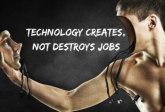How Can Tech Increase Productivity In The Workplace

Companies are increasingly turning to technology to increase productivity in the workplace by streamlining processes, automating tasks, improving communication, and providing access to valuable data and tools.
Here are several ways in which technology can enhance productivity in the workplace:
Use artificial intelligence (AI) to automate repetitive tasks
Artificial Intelligence (AI) is a broad field that encompasses various techniques, algorithms, and applications.
AI-powered solutions can automate customer support through chatbots, personalize marketing campaigns, optimize supply chain logistics, and perform data analysis at a scale and speed that would be impossible for humans.
AI-powered chatbots are taking customer service to the next level, offering round-the-clock assistance, instant responses, and a level of personalization that traditional customer service methods struggle to match.
These AI applications are not only enhancing the customer experience but also freeing up human reps to handle more complex issues, thereby optimizing productivity and enhancing overall operational efficiency. With customers increasingly expecting instant, personalized responses, AI-driven customer service tools are becoming a crucial competitive edge in the digital marketplace.
By tracking interactions and making use of predictive analytics, businesses can gain valuable market insights that can be used to tailor their products and services more effectively.
From predicting customer behavior to improving product recommendations, integrating AI into customer service can open up new frontiers of data-driven growth opportunities.
Technology can automate routine and time-consuming tasks, such as data entry, report generation, email filtering, and even basic customer support.
Automation tools and software can take over mundane tasks, freeing up employees to focus on more complex issues and allowing companies to scale quickly without sacrificing quality.
By automating certain processes, businesses can reduce their reliance on manual labor, speeding up production time and reducing operational costs.
When AI is combined with automation, it gives rise to robust solutions that surpass traditional methods in terms of sophistication.
From predictive analytics to natural language processing and machine learning, automation is paving the way for a new era of business efficiency.
Use AI algorithms for IT security and data protection
AI algorithms can analyse vast amounts of data to identify patterns and anomalies that may indicate fraudulent activities. It is used in fraud detection systems for credit card transactions, insurance claims, and cybersecurity.
Technology also plays a crucial role in securing sensitive data and protecting against cyber threats. Robust cybersecurity measures are essential to maintaining productivity by preventing disruptions caused by data breaches or downtime.
Companies are increasingly turning to outsourced IT support services as the go-to solution for boosting operational efficiency. By working with an IT help desk outsourcing company, businesses can save time and money that would otherwise be spent in-house on hiring specialised staff or investing in costly hardware.
These third-party providers offer round-the-clock support, covering everything from system maintenance and troubleshooting to service monitoring, all at an affordable rate.
These IT companies provide cloud computing services with the latest infrastructure and scalability required to meet their business needs.
By utilising cloud computing services, businesses can access enterprise software and infrastructure on demand, saving both time and money that would otherwise be spent on hardware.
Cloud-based services like Google Workspace and Microsoft 365 provide access to documents, spreadsheets, and presentations from anywhere with an internet connection. This enables remote work, flexibility, and easy collaboration on documents in real-time.
Use communication and project management software to make day-to-day operations smoother
Collaboration platforms like Slack, Microsoft Teams, and Zoom facilitate communication and collaboration among team members, regardless of their physical locations. They enable real-time messaging, file sharing, and video conferencing, reducing the need for lengthy email exchanges and in-person meetings.
Collaboration platforms enable work managers to connect with their teams, share information, assign tasks, and provide feedback.
Tools like Asana, Trello, and Jira help teams organize tasks, set deadlines, and track project progress. They improve coordination and transparency, ensuring that everyone is on the same page.
Project management software is designed to help individuals or teams plan, organise, and manage projects. It offers various features that allow users to track progress, allocate resources, set deadlines, and communicate with team members.
These tools provide features such as task management, scheduling, document sharing, and progress tracking, allowing managers to organize and monitor projects effectively. Popular project management software options include Trello, Asana, and Basecamp.
Use AI algorithms to understand markets and predict trends
Businesses can leverage data analytics tools to gain insights into their operations, customer behavior, and market trends. This data-driven approach can inform strategic decisions and lead to more efficient processes.
Advanced analytics tools refer to a set of software applications and techniques used to analyse complex data sets and extract valuable insights and patterns. These tools go beyond basic reporting and provide advanced statistical, mathematical, and predictive capabilities to uncover hidden patterns, trends, and relationships in data.
Read about other (not just tech-related) strategies to use for business growth.
Here are some common types of advanced analytics tools:
1. Data mining tools: These tools use algorithms and techniques to discover patterns and relationships in large datasets. They can identify associations, clusters, and sequential patterns within the data.
2. Predictive analytics tools: These tools utilize statistical modeling and machine learning algorithms to forecast future outcomes based on historical data. They can be used for predictive modeling, forecasting, and risk assessment.
3. Natural language processing (NLP) Tools: NLP tools allow computers to understand and interpret human language. They enable tasks such as language translation, sentiment analysis, chatbots, and text summarization.
5. Data visualization tools: These tools help in presenting complex data in a visual and interactive format. They create charts, graphs, and dashboards to communicate insights effectively.
6. Optimization tools: Optimization tools help in finding the best solution to a problem by maximizing or minimizing a set of variables within specified constraints. They are used for resource allocation, scheduling, and supply chain optimization.
Use augmented and virtual reality to aid sales and staff training
Augmented reality (AR) and virtual reality (VR) are two distinct technologies that offer immersive and interactive experiences, but they differ in their fundamental concepts and applications:
Augmented reality (AR) blends digital or computer-generated elements with the real-world environment, enhancing the user’s perception of reality. In AR, the user remains connected to the real world while digital information is overlaid or integrated into their view. The real-world environment is still visible and can be interacted with.
Common applications include mobile apps that display information about points of interest, heads-up displays (HUDs) in vehicles, and smart glasses that overlay data onto a user’s field of vision.
Examples: Pokemon Go is a popular AR mobile game that places virtual creatures in the real world using a smartphone’s camera. Smart glasses like Microsoft HoloLens provide AR experiences by projecting holographic images onto the user’s field of view.
Virtual Reality (VR) creates a completely immersive digital environment that isolates the user from the real world. Users are transported to a simulated, computer-generated environment that can be interactive or non-interactive.
In VR, the user is entirely immersed in the virtual environment, typically using specialized VR headsets and sometimes haptic feedback devices like gloves or controllers. This immersion blocks out the physical world entirely.
Common applications include gaming, training simulations, virtual tours, therapy, and architectural design.
Examples: Oculus Rift, HTC Vive, and PlayStation VR are popular VR headset platforms used for gaming and other immersive experiences. VR can be used for flight simulators, medical training, or even virtual travel experiences.
Here are some business benefits of VR and AR:
1. Training and simulation: VR/AR provides immersive and realistic training environments, allowing employees to practice skills and procedures without the need for physical equipment or real-world risks. It is used in industries such as healthcare, aviation, manufacturing, and emergency response training.
2. Product design and prototyping: VR/AR enables designers and engineers to visualize and interact with 3D models in a virtual space. It helps in product design reviews, virtual prototyping, and making design decisions before investing in physical prototypes.
3. Data visualisation: VR allows businesses to visualize complex data sets in a more intuitive and immersive way. It helps in understanding patterns, trends, and relationships in data and enables stakeholders to explore and interact with data in a three-dimensional space.
4. Remote assistance and support: VR/AR technology can be utilized for remote assistance and support. Experts can guide field technicians or customers in real-time by providing instructions and overlaying virtual information onto the user’s view.
5. Engaging marketing campaigns: AR can be used to create interactive and memorable marketing campaigns, increasing customer engagement. For instance, AR-powered advertisements can bring print materials to life.
6. Virtual try-ons: Retailers can offer virtual try-on experiences for clothing, accessories, and cosmetics, reducing the need for physical fitting rooms.
7. Personalisation: AR can tailor product recommendations and marketing content based on user preferences and behavior, enhancing the customer’s shopping experience.


